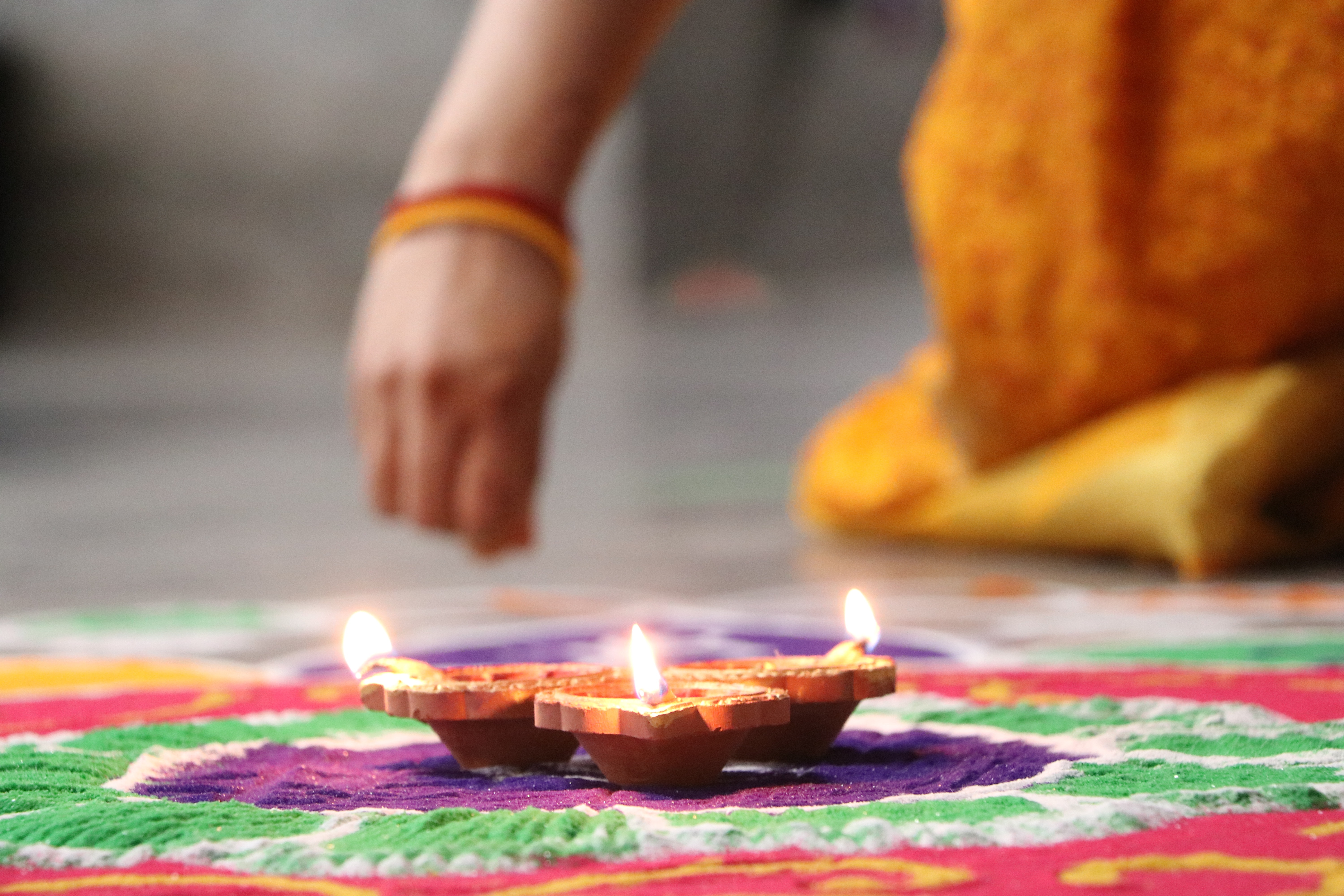Teaching Hindu Stories as Ways of Fashioning Selves and Framing Lives
Children dressed as Lord Krishna wait for a fancy dress competition. Credit: Ajay Verma/Reuters
When we introduce students to sacred texts, we often begin with what scholars and historians consider the canonized version of classics. While this approach has many virtues, especially when augmented by other tellings, it commonly fails to convey how people actually receive and engage with texts in lived religious contexts.
Growing up, children are rarely first introduced to religious narratives through the “official” versions of sacred text but, rather, they imbibe them through bedtime stories, comic books, and videos. Stories are recounted during pujas (worship services) and festival celebrations, encountered in visual representations, devotional songs, visits to temples, and as part of religious instruction. In all of these cases, the ways that narratives are transmitted involve tremendous amounts of distillation. Not only do retellings reflect regional, devotional, and other cultural differences, but they also reveal religious, moral, and ethical expectations, modes of subject formation, and processes of interpolation (as sacred narratives are seen to manifest within and/or help people to interpret their lives).
In recent years, in an effort to bring more of my own research into the classroom and in response to the changing demographics of religious studies classes, I have endeavored to offer my students the opportunity to engage more with traditions as they are lived. Here I discuss some of my pedagogic goals and two of the ways I have attempted to achieve these in my classes: through site visits to temples and the exploration of Hindu supplementary school lesson plans.
Pedagogic Goals and Possibilities
On a fundamental level, exposure to the rich stories within Hindu traditions is simply a requisite part of disseminating the basic content required to approach the subject. Without any awareness of the stories of the devas (gods) and devis (goddesses), or those recounting the transmission of knowledge, students are easily lost. Narratives not only provide an important element of background information that students need to make sense of Hindu ritual customs, but they are also engaging, generally accessible, and pleasurable ways to introduce more complex concepts and philosophies. Furthermore, exposing students to a range of narrative traditions (e.g., classical and modern, Sanskrit and vernacular, Shaiva, Shakta, and Vaishnava) provides them with some insights into distinctive theological outlooks. Stories also help to elucidate how traditions evolve over time, and how caste and gender are socially constructed and conceived differently in particular times and places.
While those aspects of using narratives to teach are laudable and substantive in their own right, I wish to focus on different pedagogical goals. Along with understanding the types of descriptive, historical, and social content that I note above, I want students to ask questions about how people make meaning out of narratives, to consider how people deploy narratives, draw upon them, are moved by them, find insights in them, and use them to interpret their lives. Additionally, examining stories in these ways helps students to think about the production of knowledge and the ways that norms and ideas are inculcated, embodied, and disciplined.
Exploring Narratives as a Means of Fashioning Children as Hindu Subjects
In the classrooms and camps of the Hindu diaspora, stories form the core of many curricula. Unlike other settings in which these stories are told, in the context of diaspora classrooms and camps, they often seem to be less about the dalliances or feats of the gods themselves and more about the human beings and demons who engage with the divine and either deviate from or follow a dharmic path. Through the act of listening to and learning these sacred narratives, children are supposed to derive personally applicable life lessons and morals.
To prompt students to think about what happens when stories become the foundation for shaping particular types of Hindu subjectivities, I bring lesson plans from Hindu supplementary schools into the classroom. Through this, students are exposed to an element of lived religion that is rarely explored and they are able to see how sacred stories are taught to American Hindu children in a didactic setting. Sometimes this involves reading through a lesson plan as one might another primary text, asking students to analyze the ways stories are framed and how activities or bodily practices are employed by educators in order to convey specific moral and theological messages. In other cases, I actually “teach” the lesson as it might be done in a classroom, asking college students to engage in the same type of games or exercises used in Hindu supplementary schools. For example, in a Chinmaya Mission curriculum, the story of the churning of the ocean, which revolves around a struggle between the asuras (described as demons) and the devas (the gods), is used to underscore how important it is for children to become wise, to discern the difference between good and bad, and to persevere and achieve their goals in moral and righteous ways. The game Red Light/Green Light is sometimes played using pictures to teach the difference between good and bad. For homework, children may be asked keep a journal of times when their asuras (personifying their bad deeds) prevailed over their devas (personifying their good deeds) and the other way around. Returning to class, they are asked share their vices and virtues, reminded that “being a good Hindu involves always standing on the side of the devas.” Students may confess to sneaking an iPad into their bed or fighting with a sibling or proudly share about the time they cleaned their room without being asked or helped set the table. They are given a piece of candy for all the times the devas won out, charged with apologizing for the times when the asuras got the better of them, and encouraged to think about how they will “be better” in the future. I have asked students to go home and try this exercise. I don’t have them share in class—I certainly don’t want to know what they view as their vices or virtues—but I do bring in candy and tell them they can take a piece for each “good thing” they did in the past week. I also ask them to imagine what it might be like to share the “bad things” in their journal in front of me and the entire class. Just thinking about how this type of reward- and confessional-system might work in their own lives illustrates how narratives are used to promote Hindu values, transmit religious vocabulary, establish norms, cultivate forms of self-discipline, and fashion moral and communal subjects.
This approach achieves multiple goals beyond acquainting students with a central story in Vaishnavite tradition. For many American Hindu students, viewing these lesson plans as primary texts allows them to see their own experiences reflected in the classroom. For students who attended religious schools of other traditions, these lessons can make Hinduism seem more familiar. And at the same time, approaching lesson plans critically can illuminate the ways that knowledge is curated and narratives are interpreted to promote particular ideas about morality. Students not only become more aware of the way Hindus shape and are shaped by stories, but this prompts them to consider the sources of their own knowledge and the ways that religious ideas become naturalized and embodied through narrative forms of discipline. Lesson plans elucidate some of the ways that children are taught to situate themselves through religious stories, recognizing themselves as part of histories and communities to which they have obligations. These seemingly simple lessons become a way to introduce Foucault’s ideas about power, discourse, and the production of rituals of truth, forms of knowledge, and selves.1
The Varied Lives of Hindu Narratives and Narratives in Hindu Lives
Inside the Minnesota Hindu Milan Mandir. Credit Religious Diversity in Minnesota Initiative
Visiting temples and engaging with practitioners of Hindu tradition can bring Hindu narratives to life in wholly different ways. In the winter of 2010, I took a group of students from my “Modern Hinduism” class to the Minnesota Hindu Milan Mandir. A few weeks earlier, we had visited the architecturally striking and elaborate Hindu Temple of Minnesota, with its marble, golden doors, and ornate gopuram. The Hindu Milan Mandir, in contrast, was housed in a one-room converted garage in the suburb of Eagan at the home of Satya Balroop. It was dark by the time we arrived and snow covered every inch of the ground and the branches of the trees. The backyard was illuminated by the light coming from the mandir, whose conventional garage door had been replaced by glass. The altar, replete with elaborately adorned images, and the bright green carpet were all that we could see as we drove in. After we observed the evening prayers and were fed a delicious Indo-Guyanese curry, I asked Satya to share her story and the story of the mandir with us. She questioned aloud why I would want the students to hear about those things rather than having them learn about Hinduism more generally; she didn’t think these personal narratives would interest them. I assured her they would.
She shared the story of her family’s migration, coming to Guyana from India as indentured servants in the mid-1800s, and her own migrations from Guyana to New York to Minnesota. Her account was punctuated with references to various gods and goddesses, God’s will, Mother Durga, and Guruji’s plan for her. In order to establish the mandir, she and her family purchased, at great expense to themselves, twelve marble murtis (sacred images) in New York. Her brother and the priest’s son packed the extremely heavy images into a rented commercial vehicle and began their drive to Minnesota. When they reached Indiana, late in the middle of the night, a deer jumped in front of the van, breaking the windshield and spinning the van around, killing the deer and totaling the truck. A series of lucky coincidences—a police officer who was patrolling the area and their fortuitous proximity to a marble dealer—made it possible for them to move the murtis to another truck and continue on their way. Satya feared that when they unpacked the crates, the murtis would all be broken. As it turned out, however, the only image that was damaged was Lord Rama, whose bow and bow-hand had cracked. For Satya, this was proof that God was guiding things all along. For just as the Ramayana recounts how Ram had to “kill a deer for Mother Sita,” so this incarnation of Ram came to kill a deer. For the devotees at the mandir, the crack in the murti is not a flaw but a sign of God’s grace, emblematic of how these stories and the gods manifest in their lives and guide them. For Satya, Ram’s broken bow transformed the accident from an impediment into a blessing from Lord Ram himself.

Snow-covered exterior of the Minnesota Hindu Milan Mandir. Credit Religious Diversity in Minnesota Initiative
The students who heard Satya’s story were able to see one of the many ways that sacred narratives come to life in affirming ways, in contrast to the politically destructive and divisive examples we had discussed in class. While not everyone can offer their students the opportunity to meet Satya and hear her story personally (although everyone can hear her voice soon, through the website of the Religious Diversity in Minnesota Initiative2), this moment changed the way I approach site visits with students. Rather than posing general questions about Hinduism, I encourage students to ask devotees if they will share something about a teaching, image of the divine, tradition, story, or ritual that they find particularly meaningful, why it resonates for them, and when/from whom they first encountered or learned it. These questions generate different answers but they almost always gesture at the ways in which people situate themselves through narrative, and how meaning, attachment, and belonging are repeatedly constituted in different ways for different people. Taking this one step further, I have developed an entire course focused on fieldwork and documenting local religion and stories, like Satya’s, from people of all different backgrounds.
Even in cases when visiting Hindu sites or engaging in fieldwork are not possible, similar goals can be achieved through studying ethnographies and comparing interpretations offered by children’s literature, films, television serials, queer communities, survivors of domestic violence, and through visual representations (e.g., various genres of sculpture and painting—medieval, modern, North Indian, South Indian, nationalistic, folk). Even small excerpts from these sources— when coupled with selections from primary sources in translation—can be effective ways to convey how people make stories their own, and how class, caste, gender, location, sexual orientation, and political outlook can change people’s relationships to narratives and how they punctuate and animate lives.
1 I realize that lesson plans are not easy to come by. I draw upon my own fieldwork when I do these lessons. However, you can find sample lessons on the web through searching for “bala vihar lesson plan,” or “bala vihar curriculum.” However, be mindful of the source of the lesson. Different organizations have radically different agendas, and you will want to be able to contextualize the messages and modes of teaching that are used into their larger socio-political context. While I use these pedagogic techniques to teach Hindu traditions, I have used similar methods when teaching Jewish traditions as well, and I believe these can work well with a variety of religious traditions.
2https://religionsmn.carleton.edu/
 Shana Sippy teaches in the Religion Program at Centre College and is codirector of the Religious Diversity in Minnesota Initiative and research associate in the Religion Department at Carleton College. She received her PhD from Columbia University and is currently working on a manuscript, Diasporic Desires: Making Hindus and the Cultivation of Longing, which explores the means by which Hindus in diaspora theorize and cultivate desires in the midst of the larger project of making Hindu subjectivities for themselves and their children. Through an examination of various Hindu realms and practices—educational, ritual, representational, political, and consumer—she considers how desire functions in the development of religious selves and sensibilities, the negotiation of public and civic spheres, and the politics and poetics of nationalism and self-representation. Her second book project focuses on the religious, cultural, and political alliances between Jews and Hindus, Israel and India.
Shana Sippy teaches in the Religion Program at Centre College and is codirector of the Religious Diversity in Minnesota Initiative and research associate in the Religion Department at Carleton College. She received her PhD from Columbia University and is currently working on a manuscript, Diasporic Desires: Making Hindus and the Cultivation of Longing, which explores the means by which Hindus in diaspora theorize and cultivate desires in the midst of the larger project of making Hindu subjectivities for themselves and their children. Through an examination of various Hindu realms and practices—educational, ritual, representational, political, and consumer—she considers how desire functions in the development of religious selves and sensibilities, the negotiation of public and civic spheres, and the politics and poetics of nationalism and self-representation. Her second book project focuses on the religious, cultural, and political alliances between Jews and Hindus, Israel and India.
Resources
I have listed only some of the many books that try to capture a sense of the wide range of interpretations of Hindu stories and their social and political implications. I have also listed some ethnographies that convey how narratives can be embodied and ritualized. Documentaries, such as In the Name of God (1992) are also incredibly effective ways to illustrate how narratives circulate, producing ideologies and political subjects. I list these few only because I have found them useful when teaching undergraduates with little background in Hindu traditions. They are far from exhaustive.
Chinmaya Mission. Bala Vihar Teachers’ Handbooks. Piercy, California: Chinmaya Mission Trust, 2007–2011.
Davis, Richard H. The Bhagavad Gita: A Biography. Princeton: Princeton University Press, 2014.
Dempsey, Corinne G. The Goddess Lives in Upstate New York: Breaking Convention and Making Home at a North American Hindu Temple. Oxford: Oxford University Press, 2006.
Gillespie, Marie. Television, Ethnicity and Cultural Change. London: Routledge, 1995.
Lutgendorf, Philip. The Life of a Text: Performing the Rāmcaritmānas of Tulsidas. Berkeley: University of California Press, 1991.
Narayan, Kirin. Storytellers, Saints, and Scoundrels: Folk Narrative in Hindu Religious Teaching. Philadelphia: University of Pennsylvania Press, 1989.
Patwardhan, Anand. In The Name of God [Rām Ke Nām] Mumbai: Anand Patwardhan Productions, 1991.
Richman, Paula, ed. Many Ramayanas: The Diversity of a Narrative Tradition in South Asia. Berkeley: University of California Press, 1991.
Vanita, Ruth, ed. Queering India: Same-Sex Love and Eroticism in Indian Culture and Society. New York: Routledge, 2013.
———. Same-Sex Love in India. London: Penguin, 2008.

